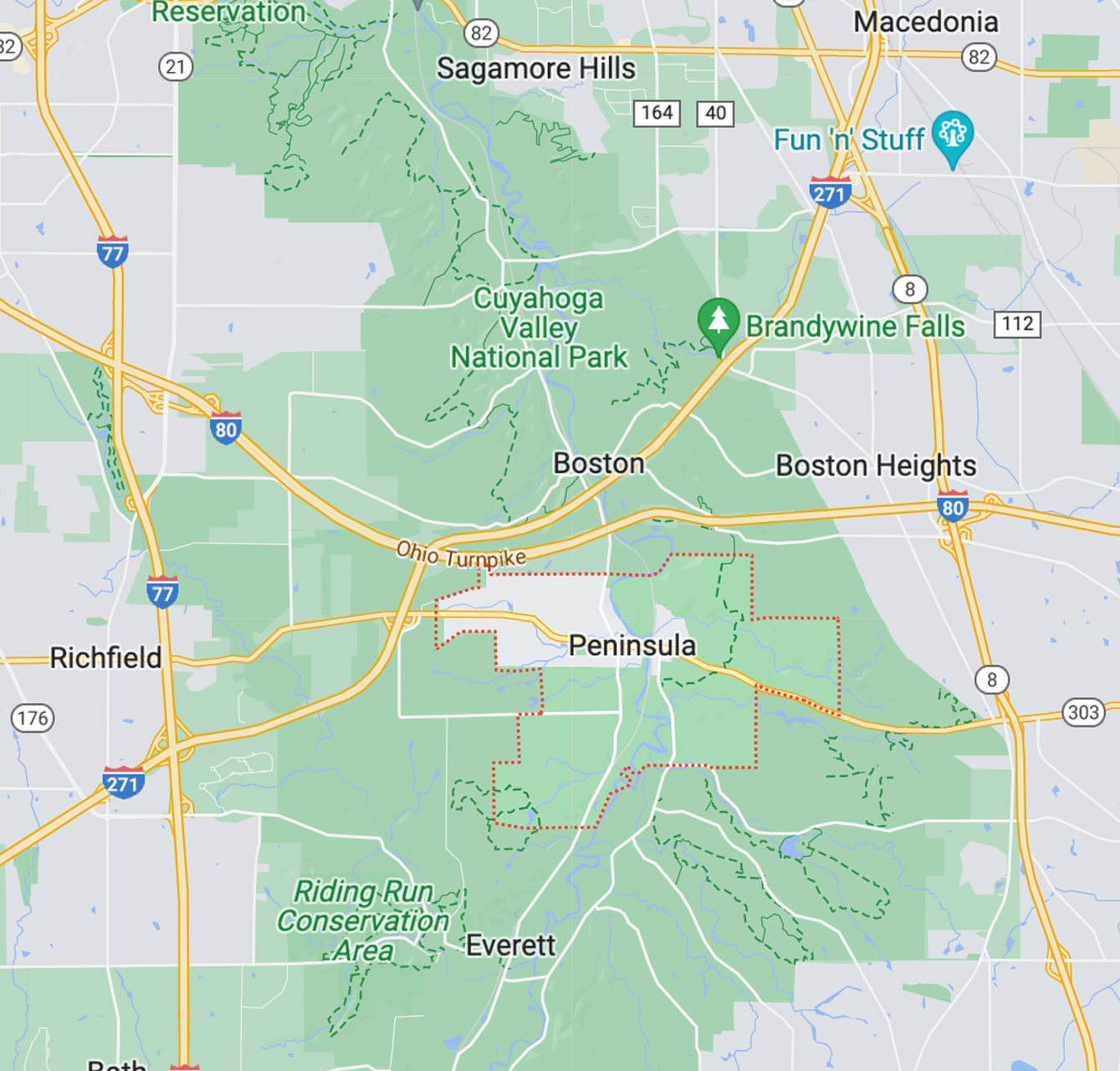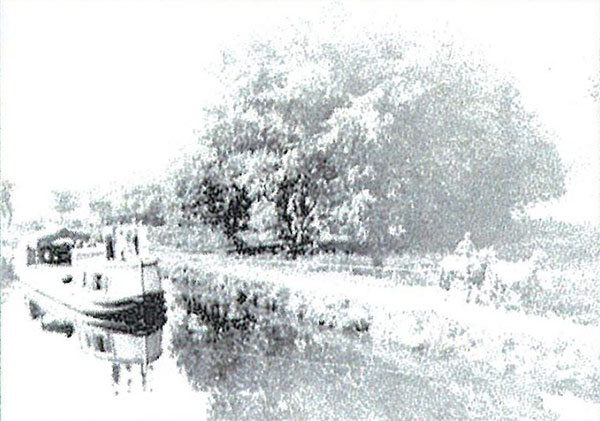About

About Peninsula
The Village of Peninsula is located in Northeast Ohio in north central Summit County, Ohio. The Village of Peninsula is considered part of the Akron Metropolitan Statistical Area {MSA), which consists of the Summit and Portage Counties. According to the 2010 U.S. Census, the population of the MSA is over 700,000 persons. The community is also part of the larger Cleveland-AkronCanton Combined Statistical Area {CSA) that collectively contains approximately 3.5 million people.
Peninsula's natural and physical features create the core of the Village's unique identity and character, and the charm that continues to be preserved and enhanced. The Village is bisected by the Cuyahoga River and located in the center of Cuyahoga Valley National Parle Both the River and the Park significantly contribute to the Village's community character.
History
Although different accounts use different terms, the history of the Village of Peninsula seems to have been most influenced by one natural feature and three man-made events. The natural feature is obviously the Cuyahoga River, which meanders through the center of the Village and, along with its surrounding topography and greenery, creates the backdrop into which the Village was placed and the "peninsula" from which the Village took its name. The man-made events include the Canal in the early 1800's, the Railroad in the late 1800's, and the Park in the late 1900's and beyond. A brief summary of these events follows:
Ohio and Erie Canal
 Much of the land in Boston Township and surrounding areas was surveyed beginning around 1800, with Alfred Wolcott of Connecticut arriving in Boston Township to survey lands belonging to Simon Perkins in 18J5. Hermon Bronson seems to have been one of the earliest settlers in what is now the Village, having settled on his land in 1824. Alonzo Dee, however, is the first known Village settler, having built and lived in his log cabin, which no longer exists. Between 1825 and 1827, construction of the Ohio and Erie Canal occurred along the Cuyahoga River, through what was to become the Village of Peninsula. Many of the 2,000+ canal workers were Irish Catholics from New York and Canada, and many remained in the surrounding areas upon completion of the canal. The canal served commerce purposes by helping area manufacturing and agricultural enterprises. In 1837, Bronson then laid out what was to become the Village, although the Village of Peninsula was not formally incorporated until 1859. Upon incorporation, and due to its location on the canal, Peninsula became the financial center of the area, with boat yards and dry docks for canal boat repair purposes, as well as hotels and saloons to support canal-related crowds. The canal continued in limited operation after the opening of the Valley Railroad (see below).
Much of the land in Boston Township and surrounding areas was surveyed beginning around 1800, with Alfred Wolcott of Connecticut arriving in Boston Township to survey lands belonging to Simon Perkins in 18J5. Hermon Bronson seems to have been one of the earliest settlers in what is now the Village, having settled on his land in 1824. Alonzo Dee, however, is the first known Village settler, having built and lived in his log cabin, which no longer exists. Between 1825 and 1827, construction of the Ohio and Erie Canal occurred along the Cuyahoga River, through what was to become the Village of Peninsula. Many of the 2,000+ canal workers were Irish Catholics from New York and Canada, and many remained in the surrounding areas upon completion of the canal. The canal served commerce purposes by helping area manufacturing and agricultural enterprises. In 1837, Bronson then laid out what was to become the Village, although the Village of Peninsula was not formally incorporated until 1859. Upon incorporation, and due to its location on the canal, Peninsula became the financial center of the area, with boat yards and dry docks for canal boat repair purposes, as well as hotels and saloons to support canal-related crowds. The canal continued in limited operation after the opening of the Valley Railroad (see below).
Valley Railroad
 An improvement in commercial transportation, the Valley Railroad upon its opening in 1880 served to supersede and replace the Ohio and Erie Canal in serving local agricultural and industrial enterprises. The Railroad also served local quarries by providing a quicker means to take stone to Akron and Cleveland for construction purposes. Polish, Slovenian, and Italian workers were among those who worked in the area's stone quarries, and many settled in the Village and surrounding areas. Financial difficulties in 1894 led to the Valley Railway's acquisition by the Cleveland Terminal &
An improvement in commercial transportation, the Valley Railroad upon its opening in 1880 served to supersede and replace the Ohio and Erie Canal in serving local agricultural and industrial enterprises. The Railroad also served local quarries by providing a quicker means to take stone to Akron and Cleveland for construction purposes. Polish, Slovenian, and Italian workers were among those who worked in the area's stone quarries, and many settled in the Village and surrounding areas. Financial difficulties in 1894 led to the Valley Railway's acquisition by the Cleveland Terminal &
Valley Railroad (CT&V).
The Baltimore and Ohio (B&O) Railroad bought the CT&V in 1915 and continued to provide freight and passenger service between Akron and Cleveland, as well as through service to Washington D.C. Upon the closing of the quarries by around 1920, due to the increasing favorability of concrete over stone for construction purposes, and the need for local residents to find work, the Railroad began to be used by area residents as a way to travel outside the community for work. As cars became more popular, this use of the Railroad began to wane. Passenger service ended in 1963. The last freight train operated by the Chessie system ran in 1985. Today, the historic rails are owned by the National Park Service. The Cuyahoga Valley Scenic Railroad organization operates the excursion train through the National Park in cooperation with the National Park Service.
Cuyahoga Valley National Park
 (f.k.a) Cuyahoga Valley National Recreation Area). Parks and open space and conservation have long been a concern of area residents, as they have recognized the natural beauty of the area and its value as a protective buffer from surrounding communities and their high levels of growth and development. In the 1970's, the United States Congress, led by local representative John Seiberling, passed legislation to create the Cuyahoga Valley National Recreation Area. In December 1974, President Gerald Ford signed the legislation that created Cuyahoga Valley National Recreation Area. The recreation area was redesignated Cuyahoga Valley National Park, the nation's 57th national park, on October 11, 2000. The Park includes nearly 33,000 acres of land, including almost half the land area within the Village of Peninsula. The Park links the urban centers of Cleveland and Akron, preserves the rural character of the Cuyahoga River Valley, and provides a local attraction for people looking for a respite from the sprawl of northeast Ohio. The Cuyahoga Valley National Park on average has drawn more than 2.48 million visitors per year. While these events have affected the Village of Peninsula, the Village has throughout the tumult retained much of its appearance and charm and maintained an almost static population for the past century. Residents like the appearance, savor the charm, and tolerate the tourists. Residents also have a calm and determined resistance to major change. In the future, the ability of the Village to continue on its current course, or to take a different course (should it so desire), will depend largely upon the level of exertion of local control and leadership. If not properly monitored and planned for, future events - much more than those in the past - could not only affect the Village, but also change its appearance, charm, and other aspects of community character.
(f.k.a) Cuyahoga Valley National Recreation Area). Parks and open space and conservation have long been a concern of area residents, as they have recognized the natural beauty of the area and its value as a protective buffer from surrounding communities and their high levels of growth and development. In the 1970's, the United States Congress, led by local representative John Seiberling, passed legislation to create the Cuyahoga Valley National Recreation Area. In December 1974, President Gerald Ford signed the legislation that created Cuyahoga Valley National Recreation Area. The recreation area was redesignated Cuyahoga Valley National Park, the nation's 57th national park, on October 11, 2000. The Park includes nearly 33,000 acres of land, including almost half the land area within the Village of Peninsula. The Park links the urban centers of Cleveland and Akron, preserves the rural character of the Cuyahoga River Valley, and provides a local attraction for people looking for a respite from the sprawl of northeast Ohio. The Cuyahoga Valley National Park on average has drawn more than 2.48 million visitors per year. While these events have affected the Village of Peninsula, the Village has throughout the tumult retained much of its appearance and charm and maintained an almost static population for the past century. Residents like the appearance, savor the charm, and tolerate the tourists. Residents also have a calm and determined resistance to major change. In the future, the ability of the Village to continue on its current course, or to take a different course (should it so desire), will depend largely upon the level of exertion of local control and leadership. If not properly monitored and planned for, future events - much more than those in the past - could not only affect the Village, but also change its appearance, charm, and other aspects of community character.Sources for the above information included Akron Beacon Journal articles; "Our Best Home Cooking': a Peninsula United Methodist Church cook book with a forward by Randy Bergdorf; the Cuyahoga Valley Scenic Railroad website; the Cuyahoga Valley National Park website; the Ohio Humanities Council website; the Peninsula Library and Historical Society website; Samuel Lane 3' Fifty Years and Over of Akron and Summit County, 1892; and William Henry Perrin's History of {Summit County, 1881).